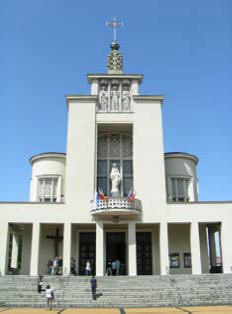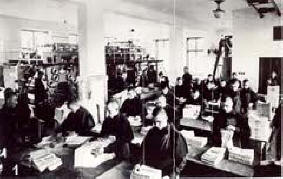|
Treasures of the Church- Holy Sites |
NIEPOKALANOW: THE
CITY OF THE IMMACULATE
by SCTJM
On
June 13th, 1927, Feast of Saint Anthony of Padua, Father Ciborowski
visited Grodno’s convent. He was known for his interest in
beekeeping. During the meal, where this particular guest was
present, the conversation was geared towards two main topics: Father
Ciborowski hadn’t ceased speaking about bees, honey, and swarms.
Father Maximilian intervened and pointed out the work that had been
carried out in Grodno. He thinks: the bees are multiplying, making
up new swarms, and we, the Brothers have multiplied. It is time to
make another swarm. But, where and how?
When it was time to say good-bye, knowing that Father Ciborowski was
soon going to visit Prince Jan Druki-Lubecki’s administrator, Father
Maximilian asked him if the Prince had another property, other than
the one he had in the region of Grodno. He also begged him to inform
the administrator about the needs of the Knight of the Immaculate
and to make sure that the Prince became interested in his plans.
Father Ciborowski gladly accepted his request and fulfilled his
mission. Weeks later, he invited Father Maximilian and his brother
to have a meeting with the administrator.
The administrator was deeply astonished and delighted with these men
of faith. A miracle had occurred in his life, the religious
indifference he had been experiencing had ceased. He now had this
great desire to help Father Maximilian with his plans, and decided
to speak to the Prince and suggest to him to give away some of the
lands he had in the region of Teresin, close to the railway station,
and not far from Warsaw.
The monks were extremely happy and they began to pray and wait for
an answer, entrusting everything to the Immaculate. In just a few
days, the administrator set up a meeting with the Prince, who ended
up being delighted and captivated by the simplicity of the religious
brothers. He offered them 5 hectares of land, next to the region of
Szymanow. Father Maximilian is extremely grateful by the Prince’s
generosity. However, he only accepted a lease, in other words, only
the right to enjoy the benefits of the land, but not the actual
property. During his first visit to these lands, he placed an image
of the Immaculate as the first stone. This took place on August
27th, of the year 1927. Father Maximilian was aware that he first
needed the permission from his superiors before he could accept
those lands.
Prince Drucki-Lubecki demanded only one condition in order to
transfer the property for free, and that was if they could offer 24
Masses annually for his intentions. The religious brothers who were
gathered in the Chaptermdid not think it was wise to accept such a
condition and refused to accept the free land. This was a trial of
Divine Providence and it also showed obedience and fidelity of
Father Maximilian. He should be the one to inform the Prince of the
Superior’s decision.
He did this, holding on to his suffering, but with a total
submission to the Immaculate. The prince listened to him in silence
and asked him to please remove the statue of the Virgin which had
previously been placed there. Father Maximilian’s response was, that
he couldn’t do it, insisting that the statue should stay where it
was, in order to show that at least once the Blessed Mother had not
fulfilled her promises. After seeing the simplicity and the profound
faith of the Franciscan monk, the prince was moved and Providence
intervened. He gave them the lands without charging them anything.
Saint Maximilian knew that the Immaculate never fails. After having
surpassed all obstacles, the Niepokalanow foundation began, and
Father Maximilian, who was 33 years old, was named the Superior of
what would be the new convent and the City of the Immaculate. The
dream of the beehive or the swarms of the Immaculate became a
reality. The first chapel was built (in a rush). This would be the
residence for the first monks who would include Father Maximilian,
Father Alfonso and 15 other Brothers. On November 21st, Feast of the
Presentation of the Blessed Mother, they celebrated the first Mass
in the neighborhood.
Holy poverty is the capital which allows us to measure ourselves
with the greatest financial powers of the Protestants, the sects,
the atheists, and of their head, the masonry……Because holy poverty
is the never empty box of Divine Providence.
The official inauguration was celebrated on December 7th, just as it
was printed on the invitation. It was sent out to friends and
benefactors and it said: On Wednesday, December 7th, Vigil of the
Immaculate Conception at 10 AM, we have the honor of inviting you to
the ceremony of the Blessing of the humble See of the “Knight of the
Immaculate” magazine, in Niepokalanow.
Father Maximilian remained as the Superior until the first months of
the year 1930, when he left as a missionary to Japan. His brother,
Father Alfonso, took over his position. He died on December 3rd, of
the same year. Father Florian Koziura, one of the first ones who
accepted the goal of the Militia, was named superior. Upon his
return from Japan in 1936, Father Maximilian was again elected as
the new Superior of Niepokalanow, and was re-elected in 1939. As
Superior, he was arrested by the Nazis on February 17th, 1941.
Structure of the City of the Immaculate
 We
are speaking here about a City, the City of the Immaculate, and you
can find in it, a true editorial complex, whose buildings are very
modest huts or shacks (rustic living quarters whose structure was in
the form of an H). The body or the central structure is comprised
of: the editorial staff, library, linotypes, photographic cabinets,
offices of engine workshops, and diverse departments for warehouse.
The left section is dedicated to the residence of the monks, where
the chapel is located, buildings for the novitiate, general
directions, the infirmary and the electrical central unit. The right
section is reserved for some offices and laboratories. This is what
comprises the exterior structure, however, it is more complex to
show the internal structure.
We
are speaking here about a City, the City of the Immaculate, and you
can find in it, a true editorial complex, whose buildings are very
modest huts or shacks (rustic living quarters whose structure was in
the form of an H). The body or the central structure is comprised
of: the editorial staff, library, linotypes, photographic cabinets,
offices of engine workshops, and diverse departments for warehouse.
The left section is dedicated to the residence of the monks, where
the chapel is located, buildings for the novitiate, general
directions, the infirmary and the electrical central unit. The right
section is reserved for some offices and laboratories. This is what
comprises the exterior structure, however, it is more complex to
show the internal structure.
The organization and the functioning of the City of the Immaculate,
with its citizens, the franciscan monks, was overseen by the
authority of the Superior of the convent (who was also the acting
Director of the editorial complex and the division of 5
departments).
1. The Editorial Staff and Administration Department: It was
overseen by 158 Brothers and it had a subdivision of 18 sections.
The Administration had 2 sections: an International section, and the
other one for National issues. There was a secretary who would take
care of everything related to the Militia of the Immaculate.
2. The Typographic Department: It was overseen by 103 Brothers and
it
had 17 sections. It was subdivided into two sections: the small
diary (Maly Dziennik) and the other one for various publications. It
had a great rotary press and all types of printing machines.
3. The Technical Department: It was overseen by 26 Brothers and it
had six sections. This particular department’s function was to
repair the machines and to take care of everything that had to do
with the electrical central union. This particular group of brothers
was known for being the ones who built the railway station between
Niepokalanow and the next railway station.
4. The Domestic Economy Department: It was overseen by 15 Brothers
and it had a division of 23 sections. This department was in charge
of the kitchen services, tailoring, gardening, infirmary, and many
more. The dining room had the capacity to have 1000 people seating
down.
5. The Construction Department: 30 Brothers were in charge of the
construction, reparations, and fixing of all the buildings. It
consisted of 8 sections. At the beginning, it was built in wood, but
with the risk and the danger of possible fires, it made it possible
for them to put a team together of firefighter-monks, which not only
will help Niepokalanow, but also those nearby towns who might also
be in need. Two kilometers away, there was a hospital, two houses of
Formation and two Novitiates for candidates aspiring to be Brothers
and for candidates aspiring to become future priests.
In the year 1939, it housed 762 religious: 13 Priests, 18 Novices,
527 Brothers, 122 boys in the junior seminary to enter the
priesthood, and 82 candidates wanting to become Brothers. Once he
had finished his studies, when Father Maximilian returned to Rome,
the Franciscan Province counted with a little more than 100 members,
between Priests and Brothers in all of Poland.
Father Maximilian knew how to communicate and inspire the charism
and the ideal of total consecration to the Immaculate. This is the
reason why vocations were flourishing and there was always work for
more and for everyone, especially for those who unconditionally and
limitlessly wanted to collaborate and become instruments in the
hands of the Queen of such a noble City.
The Immaculate throughout the world
After the City of the Immaculata was firmly established in
Poland, St. Maximilian set his sights abroad to conquer hearts
throughout the world for the Immaculata. He set off for the far east
and ended up in Nagasaki, Japan, where he established another
community. In the midst of sickness, poverty, and many difficulties,
the new community in Japan began to grow. Very soon, they had a
Japanese version of the Knight of the Immaculata, the periodical
that had flourished originally in Poland, and now in Japan. After a
few years in Japan, St. Maximilian was summoned back to Poland,
largely due to his ever-declining health.
This page is the work of the Servants of the Pierced Hearts of Jesus and
Mary
Copyright © 2006- SCTJM